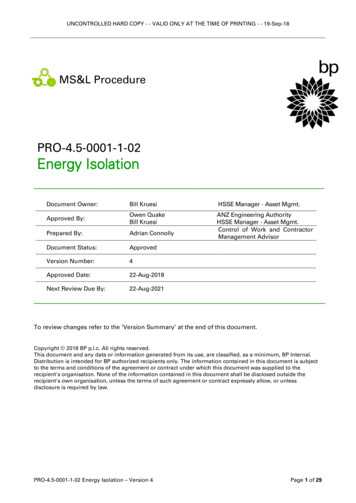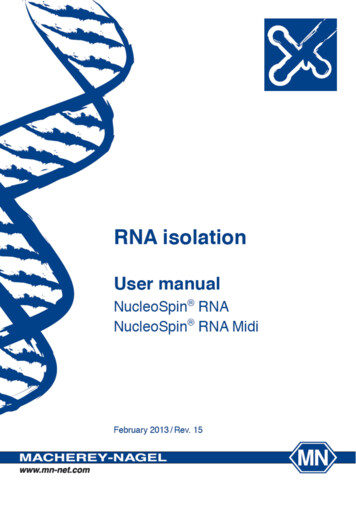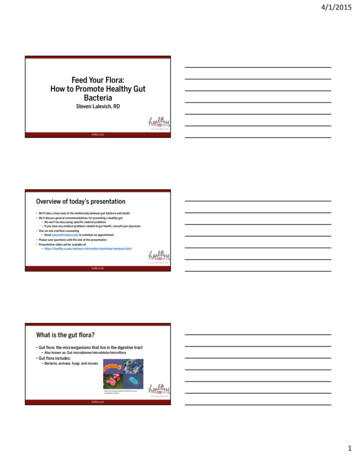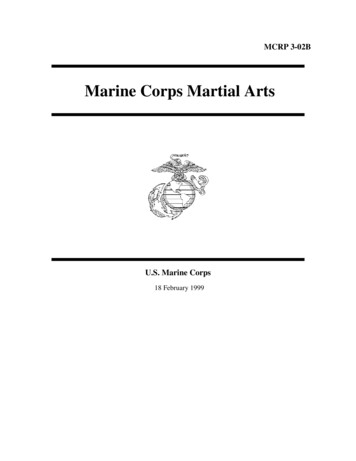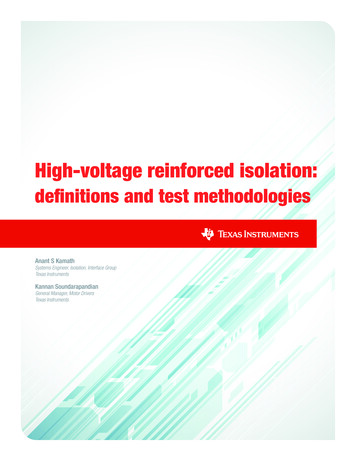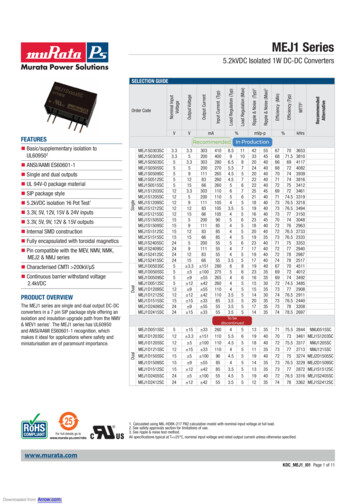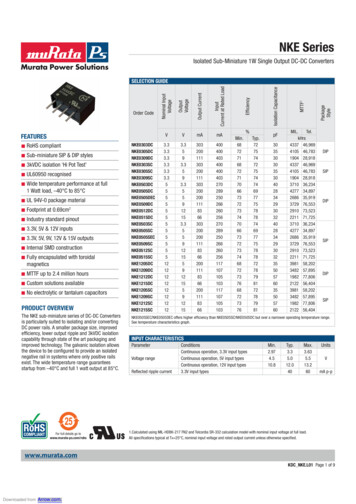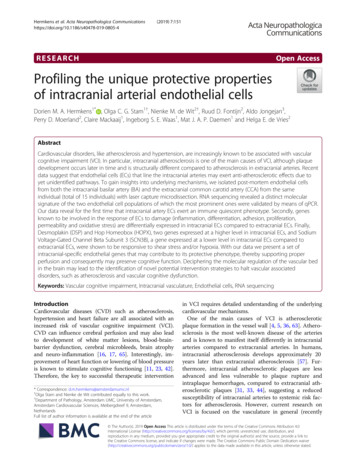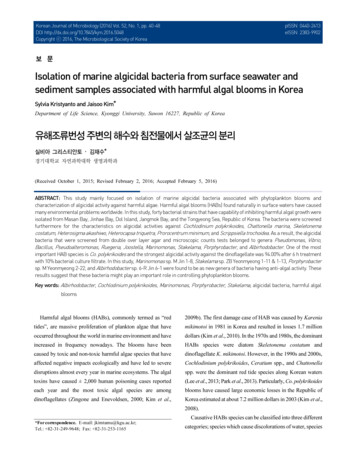
Transcription
Korean Journal of Microbiology (2016) Vol. 52, No. 1, pp. 40-48DOI http://dx.doi.org/10.7845/kjm.2016.5048Copyright 2016, The Microbiological Society of KoreapISSN 0440-2413eISSN 2383-9902보 문Isolation of marine algicidal bacteria from surface seawater andsediment samples associated with harmful algal blooms in KoreaSylvia Kristyanto and Jaisoo Kim*Department of Life Science, Kyonggi University, Suwon 16227, Republic of Korea유해조류번성 주변의 해수와 침전물에서 살조균의 분리실비아 그리스티안토 ・ 김재수*경기대학교 자연과학대학 생명과학과(Received October 1, 2015; Revised February 2, 2016; Accepted February 5, 2016)ABSTRACT: This study mainly focused on isolation of marine algicidal bacteria associated with phytoplankton blooms andcharacterization of algicidal activity against harmful algae. Harmful algal blooms (HABs) found naturally in surface waters have causedmany environmental problems worldwide. In this study, forty bacterial strains that have capability of inhibiting harmful algal growth wereisolated from Masan Bay, Jinhae Bay, Dol Island, Jangmok Bay, and the Tongyeong Sea, Republic of Korea. The bacteria were screenedfurthermore for the characteristics on algicidal activities against Cochlodinium polykrikoides, Chattonella marina, Skeletonemacostatum, Heterosigma akashiwo, Heterocapsa triquetra, Prorocentrum minimum, and Scrippsiella trochoidea. As a result, the algicidalbacteria that were screened from double over layer agar and microscopic counts tests belonged to genera Pseudomonas, Vibrio,Bacillus, Pseudoalteromonas, Ruegeria, Joostella, Marinomonas, Stakelama, Porphyrobacter, and Albirhodobacter. One of the mostimportant HAB species is Co. polykrikoides and the strongest algicidal activity against the dinoflagellate was 94.00% after 6 h treatmentwith 10% bacterial culture filtrate. In this study, Marinomonas sp. M Jin 1-8, Stakelama sp. ZB Yeonmyeong 1-11 & 1-13, Porphyrobactersp. M Yeonmyeong 2-22, and Albirhodobacter sp. 6-R Jin 6-1 were found to be as new genera of bacteria having anti-algal activity. Theseresults suggest that these bacteria might play an important role in controlling phytoplankton blooms.Key words: Albirhodobacter, Cochlodinium polykrikoides, Marinomonas, Porphyrobacter, Stakelama, algicidal bacteria, harmful algalbloomsHarmful algal blooms (HABs), commonly termed as “red2009b). The first damage case of HAB was caused by Kareniatides”, are massive proliferation of plankton algae that havemikimotoi in 1981 in Korea and resulted in losses 1.7 millionoccurred throughout the world in marine environment and havedollars (Kim et al., 2010). In the 1970s and 1980s, the dominantincreased in frequency nowadays. The blooms have beenHABs species were diatom Skeletonema costatum andcaused by toxic and non-toxic harmful algae species that havedinoflagellate K. mikimotoi. However, in the 1990s and 2000s,affected negative impacts ecologically and have led to severeCochlodinium polykrikoides, Ceratium spp., and Chattonelladisruptions almost every year in marine ecosystems. The algalspp. were the dominant red tide species along Korean waterstoxins have caused 2,000 human poisoning cases reported(Lee et al., 2013; Park et al., 2013). Particularly, Co. polykrikoideseach year and the most toxic algal species are amongblooms have caused large economic losses in the Republic ofdinoflagellates (Zingone and Enevoldsen, 2000; Kim et al.,Korea estimated at about 7.2 million dollars in 2003 (Kim et al.,2008).Causative HABs species can be classified into three different*For correspondence. E-mail: jkimtamu@kgu.ac.kr;Tel.: 82-31-249-9648; Fax: 82-31-253-1165categories; species which cause discolorations of water, species
Isolation of marine algicidal bacteria 41which produce potent toxins that can be concentrated throughsuitable as biological control agents. Many bacteria isolatedfood chains to humans causing gastrointestinal and neurologicalfrom marine coastal waters have been known as potential killersillnesses, and species which non-toxic to humans but harmful toof red tide organisms. These bacteria consist of various genera,fish and invertebrates by seriously damaging their gills throughincluding Pseudomonas, Pseudoalteromonas, Vibrio, Bacillus,production of substances (Hallegraeff, 1993). HABs are usuallyMicrococcus, Alteromonas, Cytophaga, Cellulophaga, Plano-caused by non-toxic microalgae (over 70%). However, themicrobium, Flavobacterium, Zobellia, Saprospira, Kordia,studies have concentrated to toxic microalgae rather thanHahella, Ruegeria, and Joostella (Mayali and Azam, 2004;non-toxic microalgae that have resulted in lacking informationAmaro et al., 2005; Seong and Jeong, 2013; Yang et al., 2014).about non-toxic organisms (Shi et al., 2013).Recently, many scientists have focused on the use of algicidalHABs cause harm due to the toxins (harmful metabolites) orhigh biomass of phytoplankton that causes oxygen depletion inbacteria as biocontrol to minimize the effects of HABs andcorrelations of marine bacteria-red tide species.water environment, destruct habitat for water environment, andIn this study, algicidal bacteria designated as effective strainsalter food web dynamics (Anderson et al., 2002). There arewere all indirect attack types and identified based onseveral methods to mitigate the negative effects of HABs,comparative 16S rRNA gene sequencing analysis. The effectiveincluding mechanical (application of yellow clay dispersion),strains that have the strongest algicidal activities and algicidalbiological (use of organisms as the biological agents), chemicaleffect for each algal species will be selected for further study to(use of species-specific chemical control agents), geneticinvestigate the basic knowledge about relationships between(genetic engineering of species), and environmental controlsbacteria and microalgae.(environmental manipulation/physical or chemical modificationsof the environment) (Anderson, 2009). Finding the effective andsafe algicidal agent is urgently needed before applying toMaterials and Methodsnatural bloom areas. The classical approach for detecting HABsspecies is by direct observation (with microscopes) and flowcytometry for detection of HAB populations was developed asan alternative approach.Microalgal culturesIn this study, four dinoflagellates (Co. polykrikoides, Hc.triquetra, P. minimum, and Sc. trochoidea), two raphidophytesHABs have caused environmental problem worldwide and(Ch. marina and Hs. akashiwo), and one diatom (Sk. costatum)have increased in frequency nowadays. Although there arewere used. Co. polykrikoides and Ch. marina cultures wereseveral efforts applied to mitigate the effect of HABs such asprovided by Korea Ocean Research & Development Instituteclay flocculation, no significant improvement has been achieved(KORDI), and Hc. triquetra, P. minimum, Sc. trochoidea, Hs.and might have some impacts on marine organisms (Sengco andakashiwo, and Sk. costatum cultures were supplied by the KoreaAnderson, 2004). Many reports revealed that algicidal bacteriaMarine Microalgae Culture Center at Pukyong Nationalcould be potential as effective killer of red tide organisms andUniversity (KMMCC, Busan, Republic of Korea). All culturesmany studies have focused on the relationships betweenexcept Sk. costatum were routinely maintained in f/2-Si mediumalgicidal bacteria and algae due to potential use of these bacteria(Guillard and Ryther, 1962) made of GF/F-filtered seawater atfor controlling HABs (Kim et al., 1998; Mayali and Azam,220 C under white fluorescent light (38 µmol photons/m /sec,2004; Oh et al., 2011; Yang et al., 2012).12: 12 h light: dark cycle). Sk. costatum was cultured in f/2Biological control agents such as viruses, protozoa,medium (Sigma Aldrich) made of GF/F-filtered seawater atzooplankton, protists, actinomycete, and macrophytes could be220 C under white fluorescent light (38 µmol photons/m /sec,applied as potential killers of HABs species (Nagasaki et al.,12:12 h light:dark cycle). The cell numbers of axenic algal2004; Kang et al., 2008; Zheng et al., 2013; Yang et al., 2014).culture fixed with formaldehyde 1% (v/v) were counted with aHowever, the abundances of these organisms were low asSedgewick-Rafter counting chamber at magnification 200compared to bacteria. Therefore, these organisms might not beusing a light microscope (Korea Labtech; Olympus). Algal cellKorean Journal of Microbiology, Vol. 52, No. 1
42 Kristyanto and Kimdensities were monitored routinely using microscopic counts.strains. The method used spreading of algal lawns (onto algalmedia agar plates (f/2 agar plates) as the bottom layer andBacterial cultureMarine bacterial strains used in this study were grown ineight different kinds of media. Marine broth (Difco) with/without seawater, R2A broth (MB Cell) with/without seawater,ZoBell broth (peptone 5 g, yeast extract 1 g, FePO4·4H2O 0.01g, aged seawater 750 ml, distilled water 250 ml, pH 7.2), SuperZoBell broth (ZoBell containing 20 g of glucose), DilutedZoBell broth (10% of ZoBell) (Park et al., 2002), and pureseawater were used as bacterial media.spotting of bacterial cultures onto bacterial agar media as theupper layer. In this method, 100-µl aliquots of algal cells werespread onto the bottom layer of agar plates. Then, the plateswere incubated at 20 C using a 12 h:12 h light:dark cycle andafter 3–4 days of incubation, the algal lawns were created ontof/2 media agar plates. For the upper layer, bacterial cells werespotted onto the surface of the plates and used to investigate thepossibility of bacterial strains inhibiting harmful algal cells.Isolates were precultured first into Marine broth 2216 at 25 Cfor 3 days with shaking at 120 rpm. After cultivation, theSamplingcultures were spotted onto bacterial agar media and the plateswere incubated at 25 C for 2–3 days. The appearance ofIn this study, surface seawater and sediment samples weresampled on 31 March, 01 April, and 14 July 2014. Seawatersamples were collected from a depth of 1 m using a Van Dornsampler as well as sediment samples using a sediment samplerinhibition zone around spotting area showed that the bacterialstrains had algicidal activity against harmful algal species andwere designated as effective strains that would be characterizedfurthermore for algicidal activities.in Masan Bay (35 6'12.88"N and 128 36'14.31"E), Jinhae Bay(35 6'55.77"N and 128 41'7.16"E), Dol Island (35 11'0.44"Nand 128 34'59.31"E), Jangmok Bay (34 59'38.19"N and128 40'26.38"E), and the Tongyeong Sea (34 77'86.20"N and128 39'62.73"E), Korea. The samples were placed into sterilizedglass bottles, cooled into dark ice chest and transported to thelaboratory.Identification of algicidal bacteriaTo identify the effective isolates, DNA isolation from bacteriawas performed and for PCR amplification of 16S rRNA genefragment, universal primers 27F (5′-AGAGTTTGATCMTGGCTCAG-3′) and 1492R (5′-TACGGYTACCTTGTTACGACTT-3′) were used. Sequencing was done by Macrogen Korea.Isolation and screening of algicidal bacteriaIdentification of effective bacterial strains was carried out bycomparing the almost full-length sequence of the bacteria withSeawater samples were filtered through 0.22 µm pore-sizemembrane filter (GF/F; Merck Milipore). A portion of thethose of other 16S rRNA gene sequences from Eztaxon serverdatabase (Kim et al., 2012).membrane filter paper was inoculated into the six-transwellplates containing bacterial media and the plates were incubatedDetermination of algicidal activitywith shaking at 120 rpm in 1–2 weeks at 25 C. After serial10-fold dilutions with bacterial media, 100-µl aliquots ofdiluted samples were spread onto agar plates to isolate marinebacterial strains. The plates were incubated at 25 C for 1 week,and all colonies with different colour and morphology weretransferred onto fresh bacterial media agar plates. Once purified,the isolates were then cryopreserved at -20 C containing 20%glycerol and subculture on Marine broth 2216 (Difco) beforeuse as inoculums.Initial screening for algicidal bacteria was conducted withdouble over layer agar method to isolate the putative algicidal미생물학회지 제52권 제1호To examine the algicidal activities of the effective strains, thestrains were inoculated into Marine broth 2216 medium at 25 C67for 3 days with shaking at 120 rpm (ca. 10 –10 cells/ml).Bacterial cells were centrifuged at 5,000 g for 20 min (4 C)and then immediately filtered with 0.2 µm pore-size membranefilter (Whatman, GE Healthcare). After filtration, bacterialculture filtrates were obtained and used for screening ofalgicidal activity furthermore. The algal cells were cultured inf/2-Si media and f/2 media (for Sk. costatum). 1,800 µl algalcultures at mid-exponential growth phase (10–12 days after
Isolation of marine algicidal bacteria 43incubation) were inoculated into each well of 24-well cellspending less time (about 2–3 days) than paper discs method toculture plate (SPL Life Sciences). 200 µl of each bacterialscreen algicidal bacteria. Although paper discs method is betterculture filtrate (10% bacterial culture filtrates) was added toin displaying inhibition activity, but double over layer agareach plate containing algal cultures. The 24-well plates weremethod could be potential method to screen the algicidalthen incubated for 6 hours and as control for this experiment, anbacteria strains because this method could be fast screeningequal volume of fresh Marine broth 2216 medium was added tomethod to give reliable screening results.24-well plate containing algal cultures. After 6 h treatment, aAlgicidal strains designated as effective strains were identifiedportion of sample was fixed with a formaldehyde solution atwith 16S rRNA gene sequence comparison through the bacterialfinal concentration 1% and the numbers of viable algal cellssequence database, EzTaxon-e database (Table 1). Most of thewere counted directly on a Sedgewick-Rafter counting chambersequences of effective strains showed the highest homology toat magnification of 200 using a light microscope. The algicidalsequences belonged to genera Pseudomonas (26 strains). Basedactivity was calculated as follows: Algicidal activity (%) {1 –on 16S rRNA gene sequence analysis, the effective strains(viable individuals of algal cells after the treatment / initialbelong to genera Pseudomonas, Pseudoalteromonas, Vibrio,individuals of algal cells)} 100 (Byun et al., 2002; Jung et al.,Ruegeria, Joostella, Bacillus, Marinomonas, Porphyrobacter,2008; Kim et al., 2008). The experiments were carried out inand Stakelama.duplicate for control and treatment.Many reports revealed that alga-associating bacteria particularlybelong to α- and γ-Proteobacteria subclasses and CytophagaFlavobacterium-Bacteroides (CFB) group, and there is aResults and Discussioncorrelation between decline of phytoplankton blooms andabundance of algicidal bacteria (Grossart et al., 2005; Oh et al.,Screening and identification of algicidal bacteria2011; Yang et al., 2013). Genera Pseudomonas, Pseudoalteromonas,In this study, we found forty effective strains from initialVibrio, Ruegeria, Bacillus, and Joostella are well known asscreening with double over layer agar method, and examinedalgicidal bacteria found so far (Mayali and Azam, 2004; Amarofurthermore for determination of algicidal activities. The strainset al., 2005; Yang et al., 2014). However, in our study,displayed inhibitory activity against harmful algal speciesuncommon algicidal bacteria identified as Marinomonas,tested and were designated as effective strains. The appearancePorphyrobacter, Stakelama, and Albirhodobacter that showedof inhibition zone showed that the bacteria had anti-algalalgicidal activity from initial screening with double over layeractivity (Fig. 1). Double over layer agar method is culture-agar and microscopic counts. In marine environment, the α- anddependent method used during our study to isolate the possibleγ-Proteobacteria subclasses are the majority of alga-associatingbacterial strains that have capability to inhibit the growth ofbacteria (Oh et al., 2011). It is consistent with our results duringalgal cells. This method was carried out as initial screening ofour study in which Pseudomonas sp., Pseudoalteromonas sp.,algicidal bacteria because this method was more effective byVibrio sp., Marinomonas sp. are included in γ-ProteobacteriaFig. 1. Screening of algicidal bacteria by using double over layer agar method (left to right: algicidal activity against Hs. akashiwo, P. minimum, Sk. costatum,Hc. triquetra, and Sc. trochoidea).Korean Journal of Microbiology, Vol. 52, No. 1
44 Kristyanto and KimTable 1. Summary of algicidal bacteria found in this study based on 16S rRNA gene sequencesOriginMasan BayJinhae BayDol IslandJangmok BayTongyeong SeaStrainClosest speciesIdentity (%)DZ Ma 1-19Pseudomonas cremoricolorata NRIC 018199.73MS Ma 0-4Pseudomonas cremoricolorata NRIC 018199.73R Ma 2-3Pseudomonas mosselii CIP 10525999.32M Jin 1-8Marinomonas alcarazii IVIA-Po-14bM Jin 1-13Pseudomonas mosselii CIP 10525999.32MS Jin 1-1 (1)Vibrio crassostreae CAIM 140599.93MS Jin 1-7Ruegeria mobilis NBRC 10103099.78R Jin 1-1Pseudomonas soli F-279,20899.51RS Jin 1-8Pseudomonas mosselii CIP 10525999.38RS Jin 2-8Pseudomonas taiwanensis BCRC 1775199.04ZB Jin 2-3Pseudomonas soli F-279,20899.23ZB Jin 2-9Joostella marina DSM 1959298.976-R Jin 6-1Albirhodobacter marinus N999.57M Dol 1-8Pseudoalteromonas espejiana NCIMB 212799.34R Dol 0-4Pseudomonas mosselii CIP 10525999.32DZ Ga 2-3Pseudomonas mosselii CIP 10525999.52M Ga 1-3Joostella marina DSM 1959299.86M Ga 1-6Pseudomonas taiwanensis BCRC 1775199.73MS Ga 1-5Ruegeria mobilis NBRC 10103099.35100M Yeon 1-1Pseudomonas taiwanensis BCRC 1775199.79M Yeon 3-2Pseudomonas cremoricolorata NRIC 018199.66MS Yeon 1-4Pseudomonas cremoricolorata NRIC 018198.98MS Yeon 1-1Pseudomonas cremoricolorata NRIC 018199.86R Yeon 0-1Pseudomonas mosselii CIP 10525999.25R Yeon 0-2Pseudomonas cremoricolorata NRIC 018199.59R Yeon 0-3Pseudomonas cremoricolorata NRIC 018199.25R Yeon 0-4Pseudomonas taiwanensis BCRC 1775199.52R Yeon 0-6Pseudomonas taiwanensis BCRC 1775199.66R Yeon 0-9Pseudomonas mosselii CIP 10525999.526-R Yeon 5-2Pseudomonas mosselii CIP 10525999.326-R Yeon 5-4Pseudomonas taiwanensis BCRC 1775199.66DZ Yeongu 1-4Marinomonas alcarazii IVIA-Po-14b96.18M Yeongu 1-2Pseudomonas mosselii CIP 10525999.51S Yeongu 3Vibrio alginolyticus NBRC 1563099.67ZB Yeongu 2-15Pseudomonas taiwanensis BCRC 1775199.79DZ Yeonmyeong 1-2Bacillus thuringiensis ATCC 1079299.66M Yeonmyeong 2-18Pseudomonas parafulva AJ 212999.8M Yeonmyeong 2-22Porphyrobacter dokdonensis DSW-7497.09ZB Yeonmyeong 1-13Stakelama pacifica JLT83298.36ZB Yeonmyeong 1-11Stakelama pacifica JLT83298.44subclasses and Ruegeria sp., Porphyrobacter sp., Stakelamaospirillales, the same order with algicidal bacteria Hahella sp.sp., and Albirhodobacter sp. are included in α-ProteobacteriaStakelama sp. and Porphyrobacter sp. are included in α-subclasses. Marinomonas sp. is classified into order Ocean-Proteobacteria subclasses and order Sphingomonadales. Lei et미생물학회지 제52권 제1호
Isolation of marine algicidal bacteria 45Table 2. Summary of algicidal bacteria found in this study based on 16S rRNA gene sequences. The activities were examined after 6 h incubation in which10% (v/v) bacterial culture filtrates were added to each algal cultures. For control, fresh Marine broth 2216E was added. Data are expressed as the mean SDfrom duplicate assaysHarmful algal bloom-forming speciesEffective strainsAlgicidal activity (%)Cochlodinium polykrikoidesPseudomonas sp. R Jin 1-194.00 0.00Heterosigma akashiwoPseudomonas sp. ZB Jin 2-359.12 3.91Heterocapsa triquetraMarinomonas sp. DZ Yeongu 1-473.26 2.08Prorocentrum minimumPseudoalteromonas sp. M Dol 1-860.37 2.11Scrippsiella trochoideaPseudomonas sp. MS Yeon 1-186.45 2.74Skeletonema costatumPseudoalteromonas sp. M Dol 1-868.07 0.20Chattonella marinaStakelama sp. ZB Yeonmyeong 1-1390.16 1.80al. (2014) reported that Altererythrobacter sp. LY02 (familytrochoidea (strain MS Yeon 1-1), 68.07% for Sk. costatumErythrobacteraceae) that was isolated from red tide seawater in(strain M Dol 1-8), and 90.16% for Ch. marina (strain ZBChina showed algicidal activity against Alexandrium tamarense.Yeonmyeong 1-13) (Table 2). In this study, the algicidalPorphyrobacter sp. also belonged to the family Erythrobacteraceaeactivities were found in the culture filtrates (data not shown).and showed algicidal activity against HABs species tested inThe effective strains that displayed the strongest algicidalthis study. Stakelama sp. belonged to family Sphingomonadaceaeactivities were selected for further study.and to our knowledge; this is the first report on familyAlgicidal bacteria can kill their algae prey by direct orSphingomonadaceae showing algicidal activity. Albirhodobacterindirect attack mode. In direct attack, direct physical contactsp. is classified into family Rhodobacteraceae. In familybetween bacterial cells and algal cells has been occurred, but inRhodobacteraceae, Sagittula sp., and Thalassobius sp. showedindirect attack mode, algicidal bacteria release algicidesalgicidal activity against Co. polykrikoides and in previous(extracellular substances) and degrade most of algal cells.report, these bacteria were isolated and identified from Co.Approximately 70% of algicidal bacteria require indirect attackpolykrikoides mixed bacterial community (Oh et al., 2011).mode and 30% of algicidal bacteria require direct attack mode toRuegeria sp. belonged to family Rhodobacteraceae also displayedlyse algal cells (Mayali and Azam, 2004; Roth et al., 2008). Inanti-algal activity against the toxic dinoflagellate A. catenellathis study, algicidal activity was examined using the filtrates(Amaro et al., 2005). To our knowledge, this is the first recordregard to the possibility of algicidal bacteria in releasingof genera Marinomonas, Porphyrobacter, Stakelama, andalgicides (algicidal compounds) to degrade or lyse algal cellsAlbirhodobacter displaying algicidal activity to the HABsbecause all the effective strains were indirect attack types.species. Further studies are needed to investigate furthermoreFurther studies were needed to identify the algicidal compoundsabout their algicidal mechanisms and their interactions withand the characteristics of the secondary metabolites.algae.One of the most important red tide species is Co.polykrikoides and Kim et al. (2007) reported that P. fluorescensAlgicidal activities of effective strains against HABsspeciesHAK-13 significantly inhibited the growth of Co. polykrikoidesAlgicidal activities of forty effective strains were examined.effective strain R Jin 1-1 (Pseudomonas sp.) also had significantDuring our study, bacterial culture filtrates were used foralgicidal activity against Co. polykrikoides and was selected fordetermination of algicidal activity. Among forty effectivefurther study. Lee et al. (2000) reported that the algicidalstrains, the strongest algicidal activities were 94.00% for Co.bacterium Pseudoalteromonas sp. strain A28 displayed species-polykrikoides (strain R Jin 1-1), 59.12% for Hs. akashiwo (strainspecific lysis of diatom Sk. costatum and produced an extracellularZB Jin 2-3), 73.26% for Hc. triquetra (strain DZ Yeongu 1-4),serine protease. Previous record reported by Kim et al. (2009a)60.37% for P. minimum (strain M Dol 1-8), 86.45% for Sc.considered that Pseudoalteromonas haloplanktis AFMB-008041and caused cell lysis of Co. polykrikoides. In this study, theKorean Journal of Microbiology, Vol. 52, No. 1
46 Kristyanto and Kimshowed algicidal activity against red tide species P. minimum,marina. From our knowledge, this is the first report ofbut was not able to inhibit the growth of Alexandrium tamarense,Marinomonas sp., Stakelama sp., Porphyrobacter sp., andAkashiwo sanguinea, Co. polykrikoides, Hs. akashiwo, andAlbirhodobacter sp. showing algicidal activity against HABsGymnodinium catenatum. This strain had algicidal compoundsspecies. Our results suggest that these bacteria might play role inthat may have β-glucosidase activity. Based on our results, ourcontrolling HABs. Further studies are needed to investigateisolated strains M Dol 1-8 (Pseudoalteromonas sp.) showedalgicidal mechanisms and algicidal compounds associated withsignificant algicidal activity against Sk. costatum and P.marine algicidal bacteria due to understanding the key role ofminimum. The isolated strain also demonstrated as indirectalgicidal bacteria in mitigating HABs.attackers of red tide species Sk. costatum and P. minimum.Four Dinophyceae, two Raphidophyceae, and one Bacillariophyceae were used in this study to examine the algicidal effect적 요of effective strains against harmful algal species. The 10%bacterial culture filtrates concentration was used for determination본 연구는 식물성플랑크톤의 대량증식 조절과 관련된 해양of algicidal activity in this study. Kim et al. (2008) considered성 살조능이 있는 박테리아의 분리와 유해조류에 대한 분리that culture filtrates inhibited the growth of HABs species in균주의 살조능 특성에 주로 초점을 맞추고 있다. 해수 표면에concentration-dependent manner. Previous studies reported by서 자연적으로 발생하는 유해조류번성(HAB)은 전세계적으Kim et al. (2007) demonstrated that algicidal activity depends로 많은 환경문제를 일으키고 있다. 본 연구에서는 유해조류on different growth stages of bacteria (exponential stationary 성장을 억제하는 능력을 가진 40개의 박테리아 균주를 마산lag phase) and Seong and Jeong (2013) reported that algicidal만, 진해만, 돌섬, 거제도, 통영 앞바다에서 분리하였다. 분리activity depends on the bacterial concentration. The 10% (v/v)된 균주들은 다양한 유해조류인 Cochlodinium polykrikoides,bacterial culture filtrates showed a relatively wide spectrumChattonella marina, Skeletonema costatum, Heterosigmaagainst HABs species tested. The effective strains demonstrateakashiwo, Heterocapsa triquetra, Prorocentrum minimum,relatively wide algicidal effect against dinoflagellates, raphido-Scrippsiella trochoidea에 대한 살조특성을 추가로 조사하였phytes, and diatom. It is considered that these effective strains다. 살조균주의 선별은 이중층 아가배지와 현미경 계수법을can prevent algal blooms caused by the 7 HAB species tested.이용하여 진행하였고 Pseudomonas, Vibrio, Bacillus, Pseudo-The previous study performed by Kang et al. (2008) reported aalteromonas, Ruegeria, Joostella, Marinomonas, Stakelama,broad host range with a good algicidal bacterium. The algicidalPorphyrobacter, Albirhodobacter의 속들에 속하는 균주들이bacteria that display a wide host range have more advantages in었다. 가장 중요한 유해조류인 Co. polykrikoides에 대한 가장possibility to control various host algal blooms.강력한 살조능은 10% 배양상등액으로 6시간 처리했을 때94%를 보이는 균주였다. 이 연구를 통해 살조효과를 보이는새로운 속으로 Marinomonas sp. M Jin 1-8, Stakelama sp. ZBConclusionForty effective algicidal strains were isolated from surfaceseawater and sediment samples of Masan Bay, Jinhae Bay, DolYeonmyeong 1-11 & 1-13, Porphyrobacter sp. M Yeonmyeong2-22, Albirhodobacter sp. 6-R Jin 6-1를 새롭게 찾았다. 결론적으로 이들 해양박테리아를 이용하면 식물성플랑크톤 번성을제어하는데 중요한 역할을 할 것으로 예상된다.Island, Jangmok Bay, and the Tongyeong Sea, Republic ofKorea. The effective strains belonged to genera Pseudomonas,Vibrio, Bacillus, Pseudoalteromonas, Ruegeria, Joostella,AcknowledgementsMarinomonas, Stakelama, Porphyrobacter, and Albirhodobacter.The strains degrade algal cells indirectly and demonstrate a wideThis study was supported by National Research Foundationalgicidal spectrum against Co. polykrikoides, Hs. akashiwo, Hc.of Korea (NRF-2013M3A2A1067498 & NRF-2013R1A2A2Atriquetra, P. minimum, Sc. trochoidea, Sk. costatum, and Ch.04014978) and also by the Basic Science Research Program미생물학회지 제52권 제1호
Isolation of marine algicidal bacteria through the National Research Foundation of Korea (NRF)funded by the Ministry of Education, Science and Technology(2011-0010144).We would like to thank to Dr. Jung Seung-Won and KoreaOcean Research & Development Institute (KORDI, Geoje,Republic of Korea) for providing microalgal cultures.ReferencesAmaro, A.M., Fuentes, M.S., Ogalde, S.R., Venegas, J.A., andSuarez-Isla, B.A. 2005. Identification and characterization ofpotentially algal-lytic marine bacteria strongly associated withthe toxic dinoflagellate Alexandrium catenella. J. Eukaryot.Microbiol. 52, 191–200.Anderson, D.M. 2009. Approaches to monitoring, control andmanagement of harmful algal blooms (HABs). Ocean Coast.Manage. 52, 342–347.Anderson, D.M., Glibert, P.M., and Burkholder, J.M. 2002. Harmfulalgal blooms and eutrophication: nutrient sources, composition,and consequences. Estuaries 25, 704–726.Byun, H.G., Jeong, S.Y., Park, Y.T., Lee, W.J., and Kim, S.K. 2002.Algicidal activity of substance purified from marine bacteriametabolites against Cochlodinium polykrikoides. J. Fish. Sci.Technol. 5, 150–155.Grossart, H.P., Levold, F., Allgaier, M., Simon, M., and Brinkhoff, T.2005. Marine diatom species harbour distinct bacterial communities.Environ. Microbiol. 7, 860–873.Guillard, R.L. and Ryther, J.H. 1962. Studies of marine planktonicdiatoms. I. Cyclotella nana (Hustedt), and Detonula confervacea(Cleve) Gran. Can. J. Microbiol. 8, 229–239.Hallegraeff, G.M. 1993. A review of harmful algal blooms and theirapparent global increase. Phycologia 32, 79–99.Jung, S.W., Kim, B.H., Katano, T., Kong, D.S., and Han, M.S. 2008.Pseudomonas fluorescens HYK0210-SK09 offers species-specificbiological control of winter algal blooms caused by freshwaterdiatom Stephanodiscus hantzschii. J. Appl. Microbiol. 105, 186–195.Kang, Y.K., Cho, S.Y., and Kang, Y.H. 2008. Isolation, identificationand characterization of algicidal bacteria against Stephanodiscushantzschii and Peridinium bipes for the control of freshwaterwinter algal blooms. J. Appl. Phycol. 20, 375–386.Kim, O.S., Cho, Y.J., Lee, K., Yoon, S.H., Kim, M., Na, H., Park, S.C.,Jeon, Y.S., Lee, J.H., Yi, H., et al. 2012. Introducing EzTaxon-e:a prokaryotic 16S rRNA gene sequence database with phylotypesthat represent uncultured species. Int. J. Syst. Evol. Microbiol. 62,716–721.Kim, M.J., Jeong, S.Y., and Lee, S.J. 2008. Isolation, identification, andalgicidal activity of marine bacteria against Cochlodiniumpolykrikoides. J. Appl. Phycol. 20, 1069–
safe algicidal agent is urgently needed before applying to natural bloom areas. The classical approach for detecting HABs species is by direct observation (with microscopes) and flow cytometry for detection of HAB populations was developed as an alternative approach. HABs have caused environmental problem worldwide and
